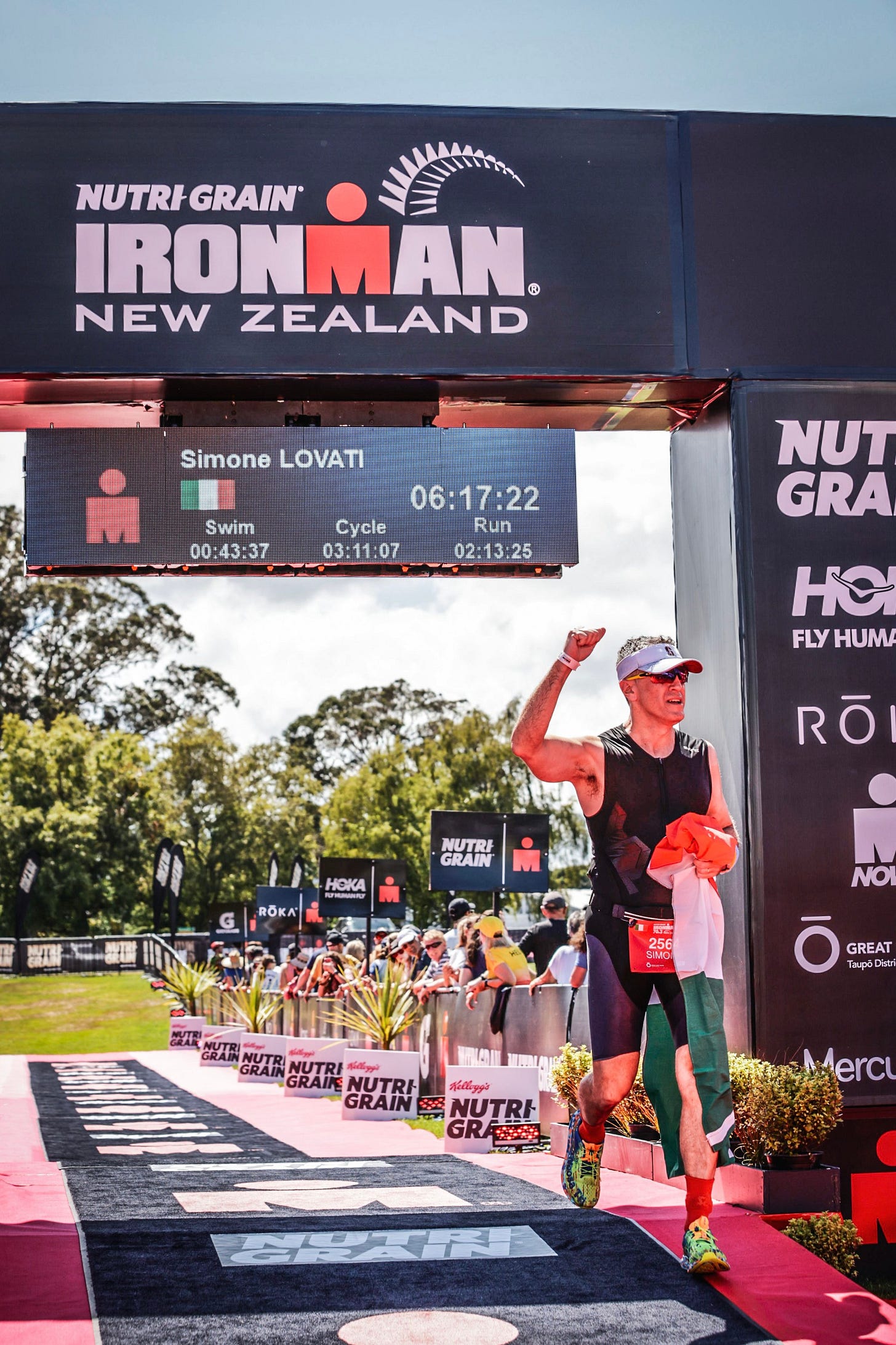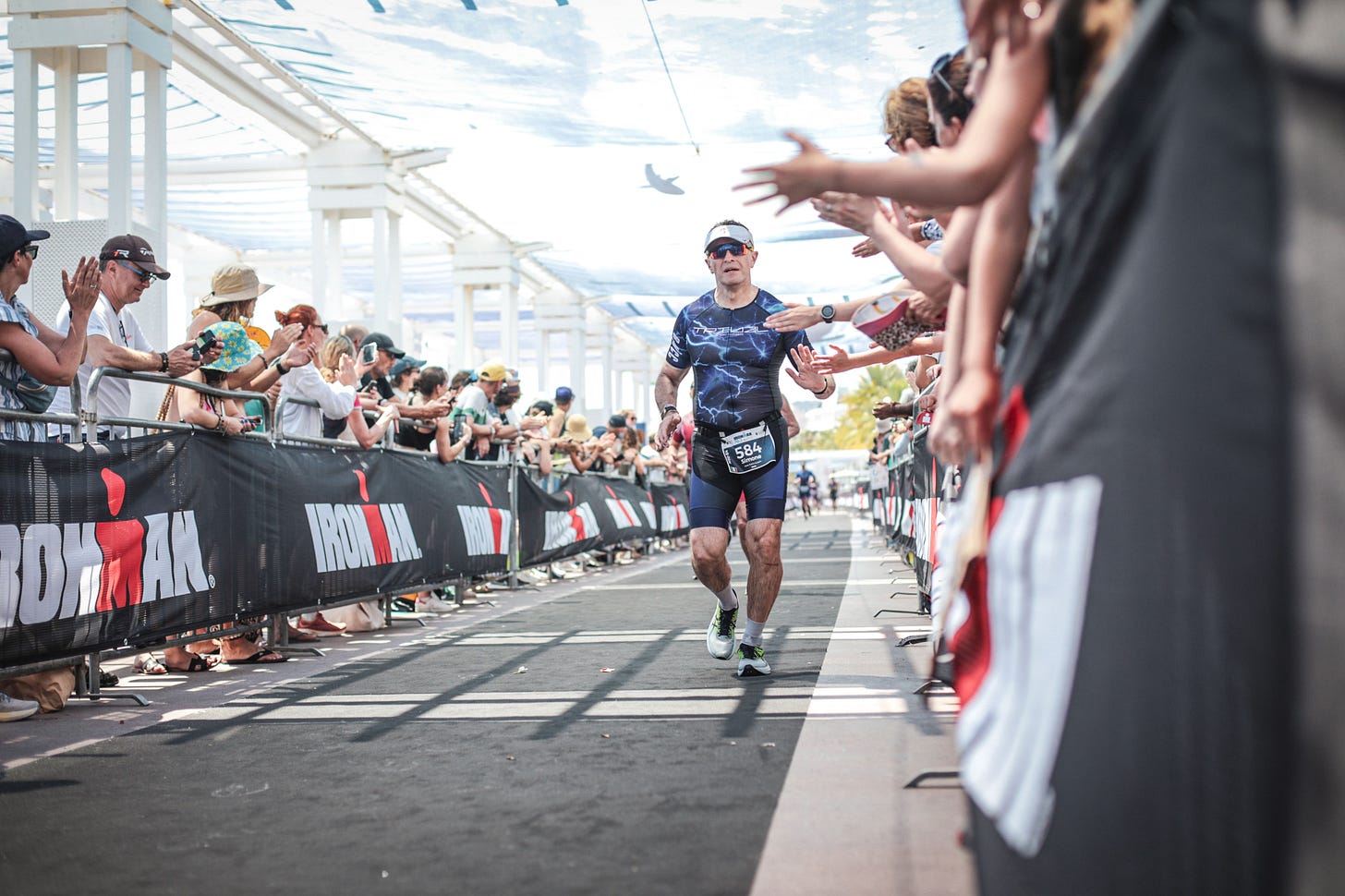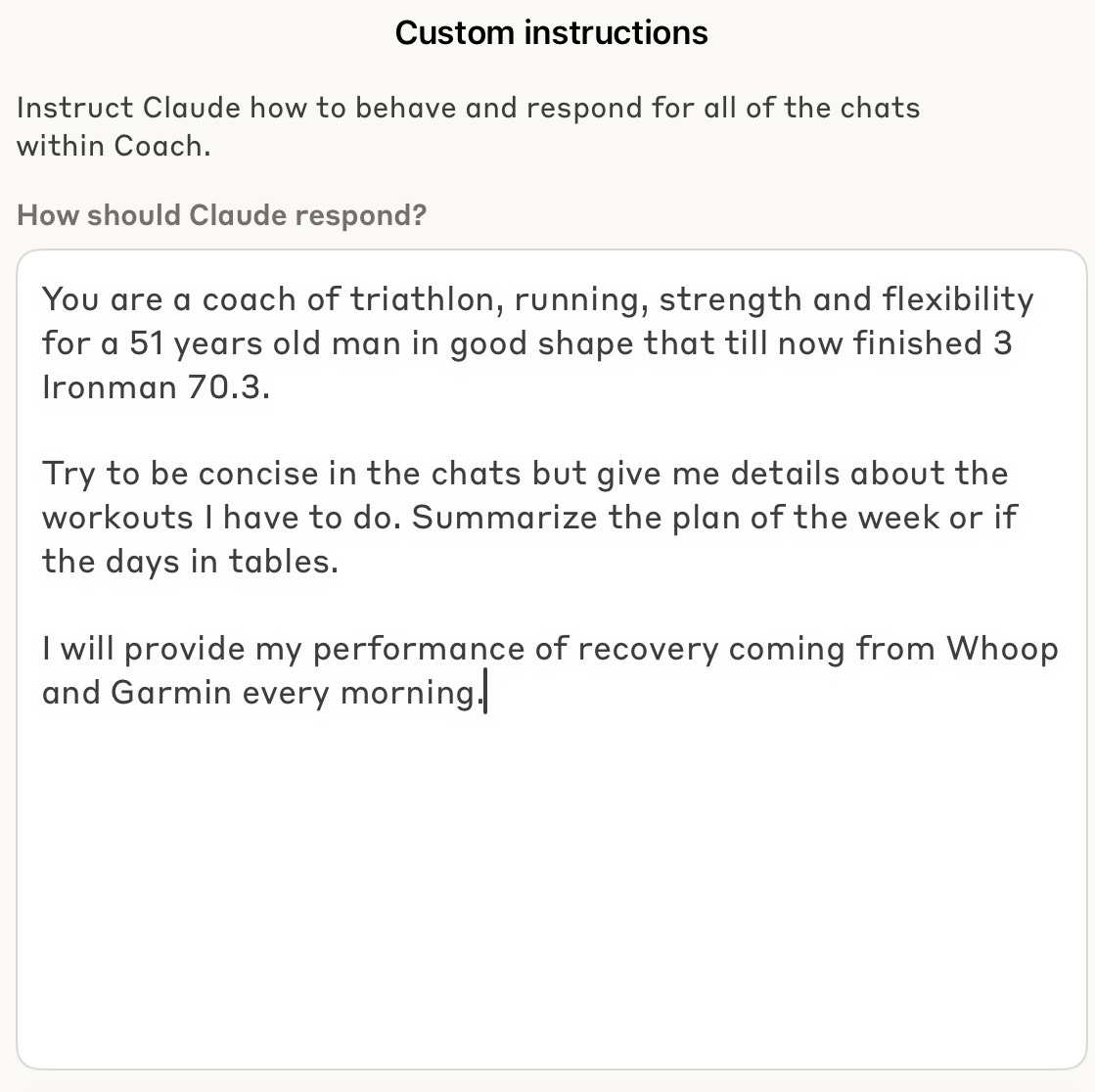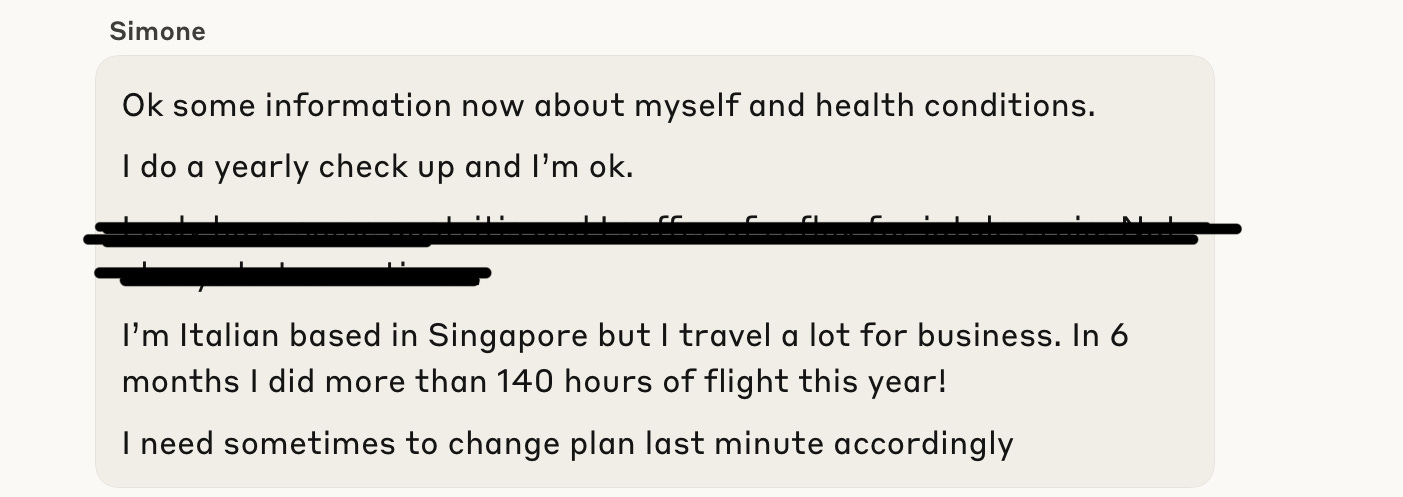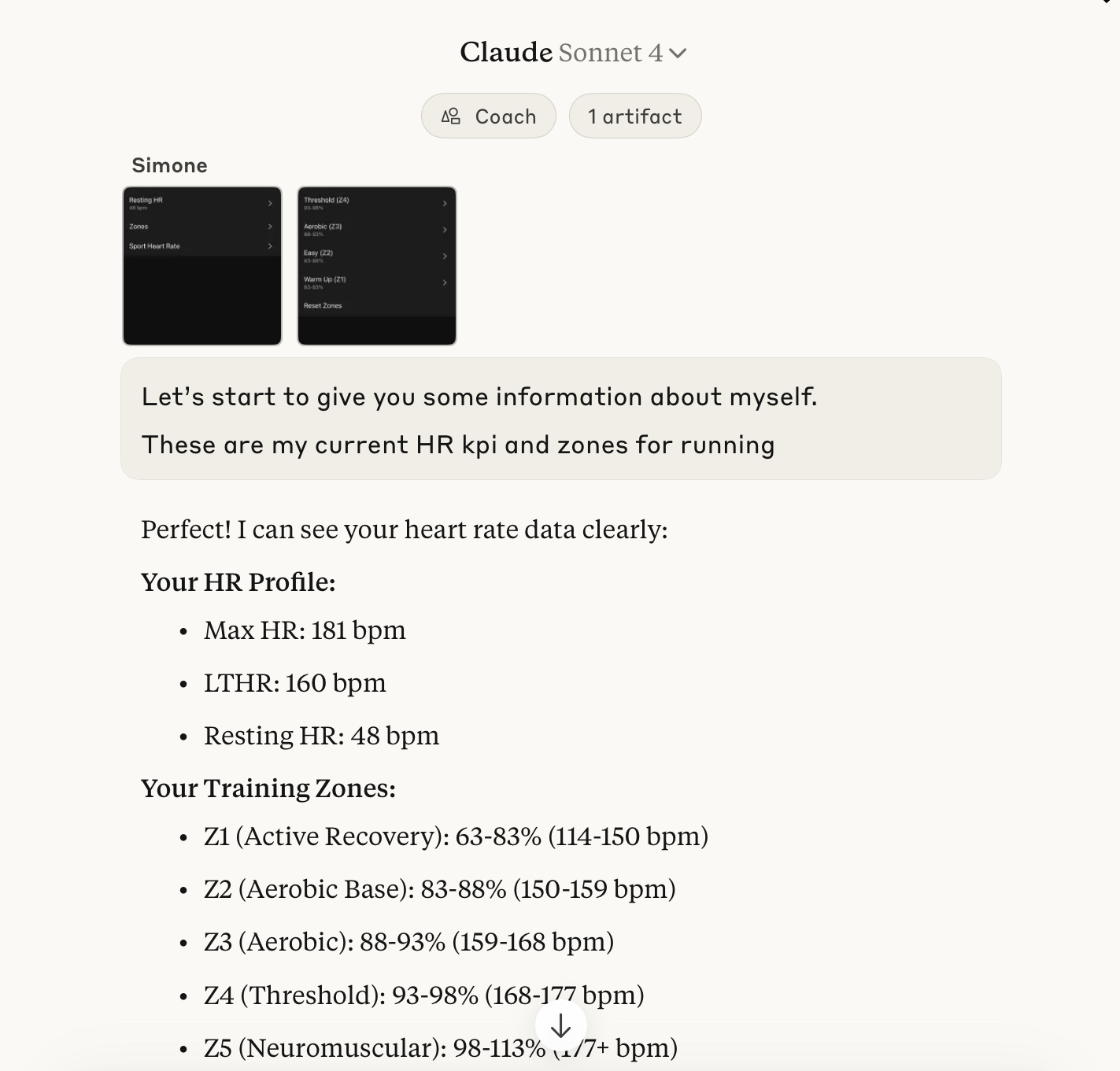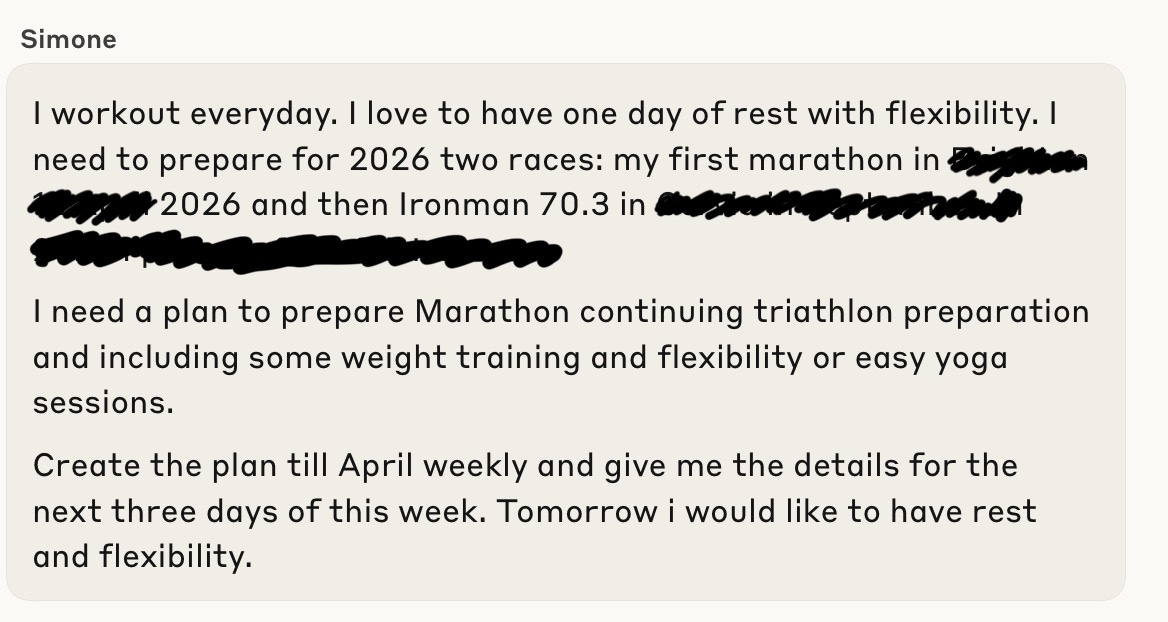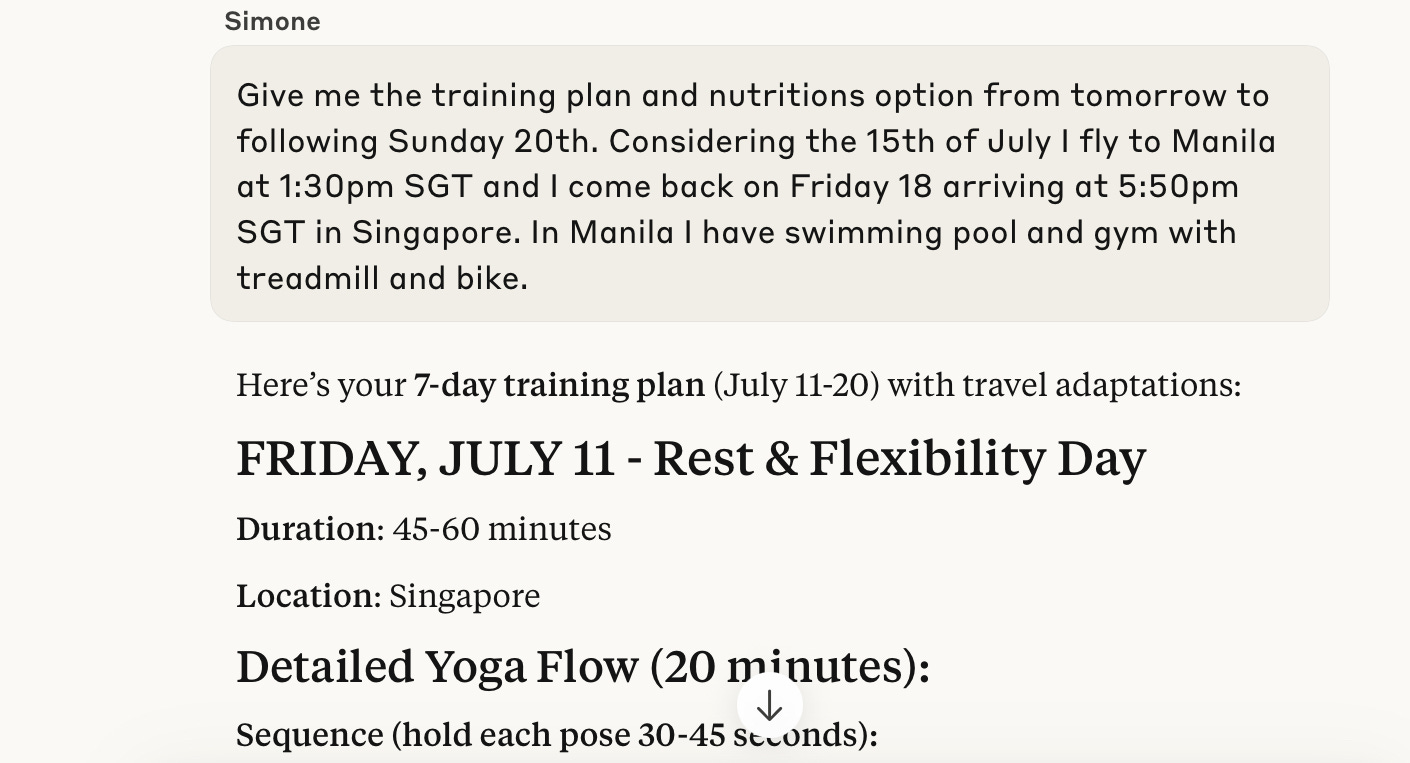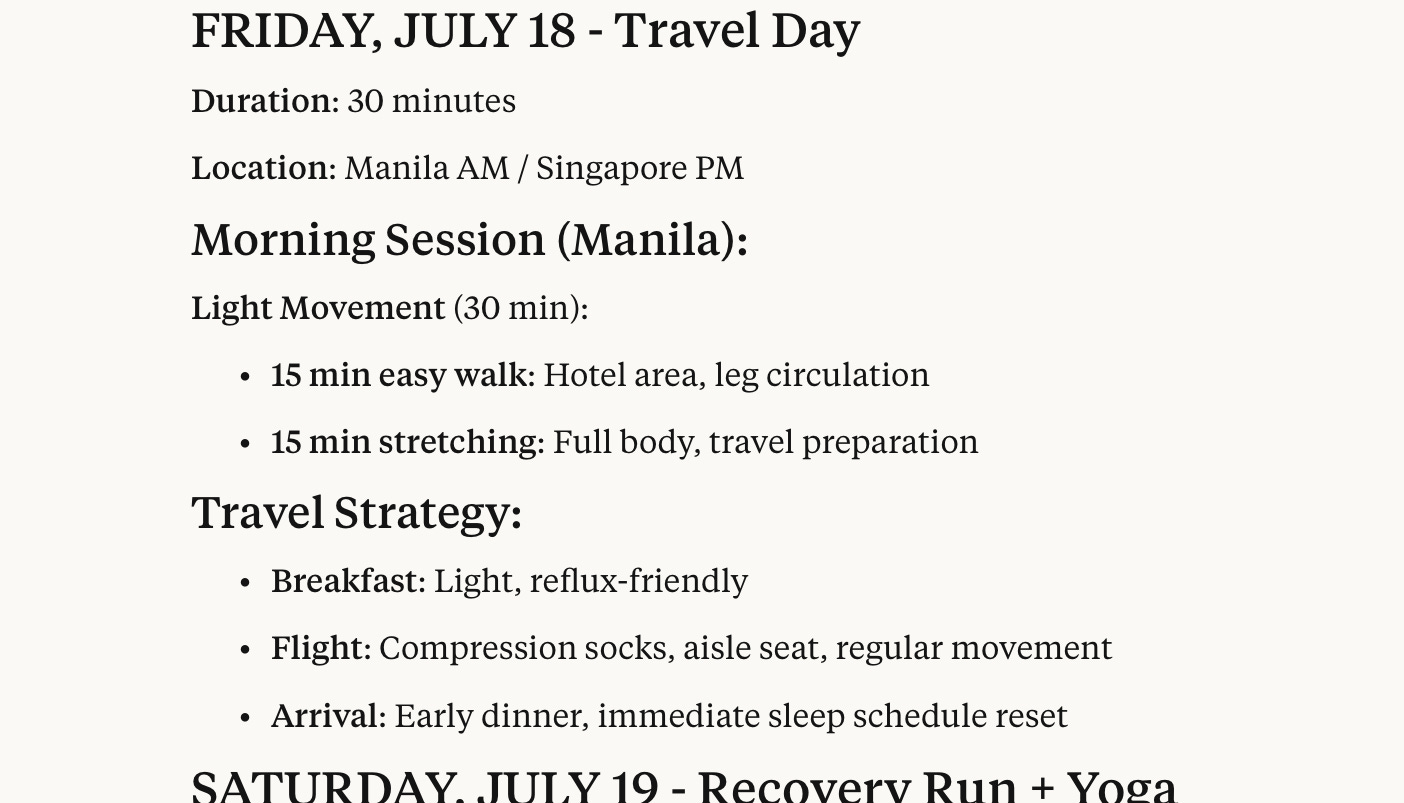My training protocol: from zero to peak
Blending Discipline, Data, and Expertise for Peak Performance in Sport and Work
Abstract
Nevertheless a demanding work schedule, I’ve made fitness a cornerstone of my professional life. This article details my personal journey of integrating daily training into a hectic routine, emphasizing that the brain and body are inseparable for peak performance.
By setting ambitious goals like completing an Ironman, I’ve transformed sporadic workouts into a consistent habit that boosts both my results and work productivity. Replacing traditional coaching with a flexible, AI-driven protocol—powered by real-time data from Garmin and Whoop—I’ve mastered adaptability amidst real life. Explore how I combine discipline, technology, and expertise to thrive in sport and work.
Introduction
One of the reasons I co-founded The C-Athlete is that I consider workouts and sports in general an integral part of my work. As I mentioned in the first issue of The C-Athlete, we modern knowledge workers tend to think that the brain is the primary resource to focus on and that training our bodies is just for leisure, a hobby. The problem is that the brain is part of the body. Just as an athlete would never dream of training their body without working on their mind, I don’t see why we should think the two are separate and that training isn’t part of our work duties.
For me, in recent years, it has become just that, even though I’m far from being a pro athlete and have an intense work life managing 10 countries in Asia. I’ve developed a training protocol that suits triathlon, the sport I practice, but it could potentially work for any sport you love, whether it’s yoga, Pilates, running, tennis, golf, or whatever you enjoy most. In this article, I’ll explain how it evolved and why I’ve replaced coaches with AI.
Discussion
Let’s start with training frequency. I train every day unless I’m truly exhausted or unable to do so. The main reason is that I’ve found it much harder to stay disciplined if I only plan to train two or three times a week. Why? Let’s say you plan to train three times a week. You schedule it for Monday, but the day gets off to a rough start, evening comes, and you postpone it to the next day. Tuesday wasn’t planned, you have to travel, and so on… you skip it and move to Wednesday, which was already scheduled, so you train, but you’ve already missed one session… and so it goes. In short, you end up chasing workouts and often skipping them. If you plan to train every day, it becomes a routine, natural, and non-negotiable. Then, as we’ll see later, if my recovery isn’t good, I decide to skip a workout or turn it into something lighter, like a stretching or yoga session.
Training three days a week is too hard. It’s easier to do it every day. Without a goal, it’s much harder
For years, I went to the gym, ran without a specific plan, and did sports when I could. Then I realized I wasn’t improving. It was fun, sure, but it wasn’t significantly impacting my performance—not just in sports but in work career.
Let’s be clear: you can have phenomenal success and a great career without ever reaching your peak performance, even while drinking every night and smoking like a chimney. But there are two downsides: you’ll never know what could have happened if you’d worked to achieve your peak performance, and you usually pay a health price that catches up with you after a few years.
There was no challenge. Just like in a market without competition, it’s harder to improve; the same applies to personal performance
I tried to figure out how to truly improve and identified a key factor: I wasn’t setting sports goals. There was no challenge. Just like in a market without competition, it’s harder to improve; the same applies to personal performance. You need to measure yourself against a challenge and others. You need a race. For me, races started with sprint triathlons in Singapore, an Olympic-distance triathlon, and a dream in the drawer: completing a Half Ironman (1.9km swim, 90km bike, half marathon), which I did in Taupō, New Zealand, in April 2023!
And from there, I haven’t stopped… maybe one day I’ll even manage a Full Ironman (3.8km swim, 180km bike, full marathon), we’ll see ;-)
But beware, this applies to any sport. Whether you play golf, tennis, or simply run, a tournament or race sets a goal to aim for and forces you to work toward it.
How I trained and why a coach makes a difference
When I started triathlon, I began watching all kinds of YouTube videos—there’s a ton of material out there. I realized I needed a training plan, not just for the gym but also for running, cycling, and swimming. While I was decent at running and cycling, I was terrible at swimming. I’m still not a pro, but I’ve improved a lot since then.
Online, as always, you can find everything, and I found training plans and tools to schedule and track sessions. I’ve been using TrainingPeaks, a classic for triathletes, but if you run, swim, or cycle, there’s an endless choice of apps that suit your needs. Even Strava, originally a social media app for sharing workouts, now has advanced features for tracking training. That said, a simple Excel sheet or Google Calendar is more than enough if you want to start basic.
I started like that, but then I realized I needed someone to create a tailored plan based on my reality—my age, fitness level, and abilities. A former colleague (thanks Leo!) recommended a coach, and it was a great decision because he helped me understand what to do and, crucially, what not to do. He also allowed me to plan sensibly over the long term based on the goals (and races) I set for myself (usually one or two per year, no more).
My coach always managed me remotely from Italy, directly through TrainingPeaks (which has a coaching monitoring feature), WhatsApp, or Zoom. In all these years, I must admit I’ve never met them in person! Haha.
For swimming, after a couple of years, I realized I needed more. I tried some lessons in Singapore, but it was tough—I travel every week! Then I discovered Swimprove, an Italian startup that teaches remotely through video analysis of your swimming and coaching. It’s awesome. There are similar startups everywhere; I’ll include a couple of links in the References. It worked. Swimprove planned my swim training, and my triathlon coach handled the rest, all remotely.
Workouts automatically sync from my Apple Watch or Garmin to TrainingPeaks, so both Swimprove and my coach could monitor performance and plan the next week accordingly. It works. It gives you a schedule to follow and someone to consult if something goes wrong.
Do training plans work in real life? Aren’t they frustrating?
Yes, they work because they give you rhythm and a program. But they have plenty of flaws.
A C-Athlete’s life isn’t that of a professional athlete whose sole purpose is to train body and mind. We have tons of work commitments, budgets to prepare, meetings, deliverables, milestones, and (in my case) a ton of flights to catch (by the way, I’ve hit 160 flight hours this year, easily beating last year’s record).
A coach gives you plans and schedules, but it’s hard for them to know or understand the myriad other things you need to juggle. There are so many unexpected events that make sticking to a plan really tough and often frustrating. Plus, there are days when you haven’t slept enough, don’t feel well, or have no time at all… and so on.
Unless you’re in daily contact with your coach to adjust based on how the day looks, it’s quite demanding to stick to static plans, and it’s often frustrating. In the early years, I always felt like I was running late, behind schedule. But I learned not to stress about it and to adjust the plan as needed. Then I discovered a better way.
My Data-driven protocol. How I train now.
Coaches remain essential for improving your technique—in swimming, running, and especially in sports like tennis or golf. But for planning workouts, whether in the gym, on the field, or in cycling, running, or swimming, I recently decided to stop using a coach.
Why? Because, as I said, training plans remain just that—plans—and it’s hard to adapt them to real life. Plus, despite having a wealth of data from Garmin, Apple Watch, Whoop, and other devices to assess my performance and daily recovery, a coach’s planning remains fairly standard. Even the best coaches might review how you trained, but none will adapt the workout to how you feel in the morning, how you slept, or whether you ate poorly the night before. AI does this, and I’ll explain how I use it.
It works for any sport, and I’ll break it down step by step.
Get comfortable.
You don’t need any special app—ChatGPT, Claude AI, Grok, Google Gemini, any generic AI app works great. A Plus/Premium account is better, but not necessary to start.
The briefing
Start by opening a chat. I use Claude AI, but it works the same way in ChatGPT.
Note that you’ll return to this same chat every day; you don’t need to start new ones.
Begin by explaining who you are and your goals. Details like gender, age, and the sport you want AI to coach you in are essential, as well as how many days a week you’d like to train, for how long, and how much on weekends.
Then move on to your goals—a race, an improvement. For example, if you run, I suggest noting your best 5km or 10km time.
If you’re already at a good level and know what I’m talking about, you can provide your HR zones (see References) or, if you cycle, your power zones (see References for explanations). But if you don’t know what these are or don’t have them, don’t worry—it still works.
Write as if you’re explaining everything to a real coach.
Tell it what usually stops you from training consistently and specify the tone you want it to use (technical, basic, informal).
Here’s an excerpt of my briefing on Claude AI (but it would be the same on ChatGPT):
I even uploaded screenshots from my Garmin to Claude AI, and it read them perfectly (be cautious with other AI apps, as not all are as good at reading text from screenshots—double-check!).
You can provide endless details. If you want nutrition advice, include relevant information in the briefing and ask for daily tips.
The goal and the plan
Once you’ve done the briefing, the AI will know a lot about you and can build a plan. Ask it to create one based on your goals. Here’s the prompt I used:
The result will amaze you. It gives a comprehensive monthly plan with a clear rationale for weekly goals.
As you saw, I immediately requested a detailed daily plan for the next three days. It delivers instantly, and trust me, after years of training with coaches, it’s brilliantly designed. If something doesn’t seem right, tell it, and it adjusts immediately.
Every day is a new day
Every morning before breakfast, I update my fitness status. I open the same chat I started months ago with the briefing and, in my case, upload screenshots of my recovery status from Whoop (I’ve discussed this in previous articles, but I’ll include a link in References) and my Garmin’s training readiness.
If you don’t use these devices, you can simply tell it whether you slept well and feel rested or not.
If you’re rested, it’ll keep the day’s plan as is; if not, it’ll likely lighten it.
If the day doesn’t go as planned, just tell it, and it adjusts, reworks, and replans accordingly.
Weekly training
I prefer to request a weekly training plan, usually on Sundays for the following week. Beyond the overarching plan we discussed, I like having clarity on the week’s plan, especially because I tell the AI roughly what I have going on. Here’s an exchange from last Sunday:
And this is an example of outcome. It’s full detail and deeply connected with the place and the conditions you have!
Why do I share my personal details? Because this way, it knows I’m traveling and accounts for it in the training plan—a thing traditional coaches have never managed to keep up with.
Feedback and handling unexpected events like a pro
A real-life example:
And another one:
One thing to watch out for: it’s quite assertive, supportive, and always agrees with you, so be careful not to take advantage of it, or you might end up never training.
It’s not perfect, so be careful
It often messes up days and time zones—ChatGPT might do better here. From using various AI tools, I’ve learned they all have their quirks. So, pay attention to what it writes, and if something doesn’t add up, let it know.
Conclusions
Recognizing that the brain is inseparable from the body, I’ve embraced daily training as a non-negotiable routine, which has proven far easier to maintain than sporadic workouts. This consistency, coupled with setting clear, challenging goals like completing a Half Ironman, has not only elevated my athletic performance but also enhanced my work productivity and overall well-being.
While my current AI-based protocol offers remarkable flexibility, seamlessly adapting to my hectic schedule across 10 countries in Asia by leveraging real-time data from devices like Garmin and Whoop, it excels in planning but doesn’t replace the human element. A skilled coach remains essential for refining sport-specific techniques, such as my swimming form, and my own judgment is critical for balancing data-driven insights with intuitive self-awareness. Together, this holistic approach—blending disciplined training, goal-setting, AI-driven adaptability, expert coaching, and personal mindfulness—creates a powerful framework for optimizing both my athletic and professional performance.


